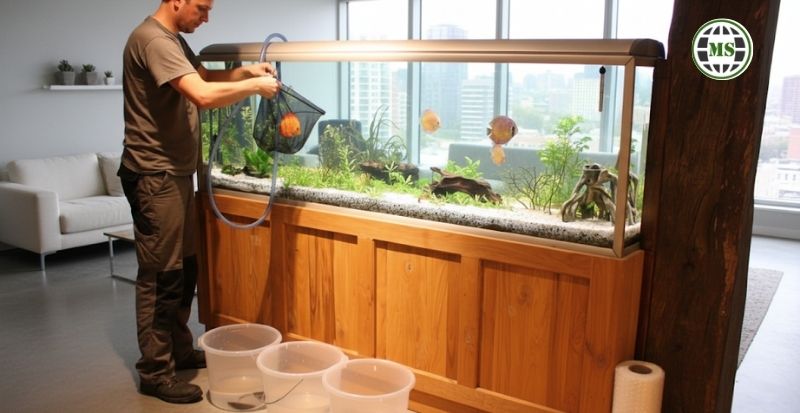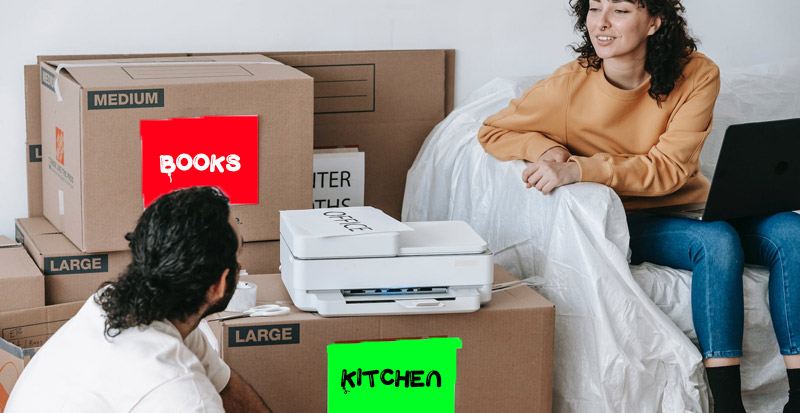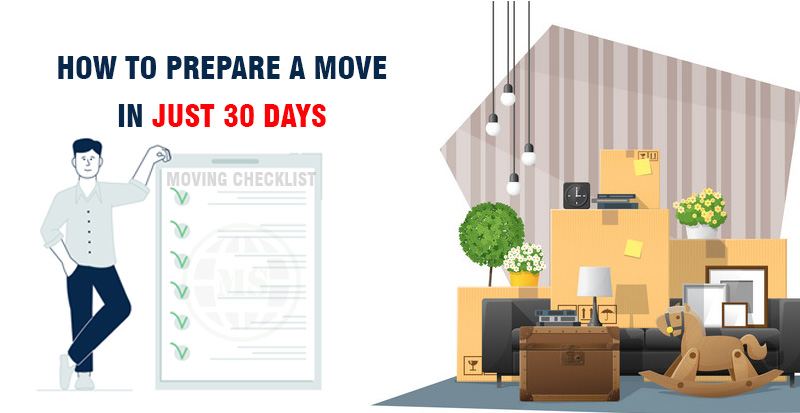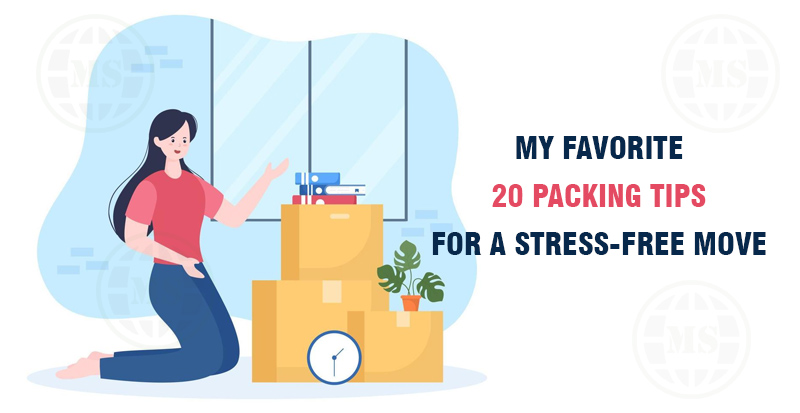Moving an Aquarium: Quick Overview
Do you want to move an aquarium when moving from one place to another? Let’s face the truth. Moving an aquarium is not as easy as you think. It can be daunting, especially when your aquatic companions are delicate and sensitive. It is more than transporting a glass box. Moreover, it is moving an ecosystem. Fish, plants, bacteria, heaters, and fillers all play a role. There are unique challenges associated with hauling an aquarium filled with small creatures. However, you can move your aquarium safely by understanding the correct methods and techniques. The best moves start with a plan—a concrete plan, you know. Your plan should focus on reducing the stress, keeping fish and beneficial bacteria alive, and protecting glass and gear. If you have clear steps, you can move your aquarium safely like a pro.
Before You Move an Aquarium: Planning
Measure and map the job
- First, measure the fish tank and its stand.
- Note the weight when full. Check doorways, stairs, elevator clearances, and vehicle space.
- Create a simple map that shows the location of the tank in the new room.
- If the tank is large, plan for extra help or professional assistance.
Decide what to move and what to replace
Some items travel poorly. Old filter cartridges, worn tubing, cheap lights, and tired heaters are easy to replace. Live rock, filter media, and the bulk of the water are worth moving. If you will replace gravel or decor, plan the safe removal. Remember that replacing some parts can reduce risk and simplify the job.
Timing and route
This is one of the most overlooked steps when moving an aquarium. But you must take this step on a serious note. Pick a cool day if possible because heat causes stress to fish. Consider moving the aquarium during daylight hours. Additionally, plan the route from the tank to the vehicle to the final location. If you are moving the tank by your car, avoid long waits in hot cars. Estimate the time the fish will be out of the tank and prepare accordingly.
Supplies You Will Need to Move an Aquarium
Fish and water
- Sturdy buckets with lids, clean and food-grade.
- Aquarium-safe plastic bags or heavy-duty fish transport bags.
- Battery-powered air pumps or oxygen canisters for long trips.
- Dechlorinated water or pre-mixed water for top-up.
- Net, siphon, and water test kits.
Tank and glass
- Blankets, towels, or moving pads for cushioning.
- Bubble wrap or foam sheets for corners.
- Strong tape and straps.
- Cardboard and a rigid board to support the base.
- Markers and labels for fragile and orientation.
Plants, corals, and hardware
- Small sealed containers for corals or sensitive plants.
- Zip ties or strings for trimming and bundling plants.
- Sealable bags for loose parts, screws, and the manual.
- Replacement oxygen and water conditioners.
Preparing Fish, Plants, and Coral
Reduce stress before the move
- Begin 3 to 5 days before the move.
- Lower the feed amount.
- Keep the water clean.
- Avoid water changes in the 24 hours before the move unless necessary.
Stress from handling and poor water quality compounds during transport.
Fasting and feeding rules
- Stop feeding 24 hours before the move for most tropical fish. This reduces waste and water pollution.
- For herbivores and some large species, a light feed 12 hours before can be okay. Remove uneaten food quickly.
Quarantine and fragile species
If a fish is ill or very delicate, consider moving it in a separate, quiet container with oxygen. For aggressive species, separate them to avoid fights. Corals that are easily stressed may need to travel in stable, oxygenated water with low light.
Handling the Water and Beneficial Bacteria
How much water to keep
Keep as much aquarium water as you can. Moving water preserves chemistry and bacteria. For small tanks, keep about half to two-thirds of the water in secured buckets or containers. For large tanks, you may keep more in the tank and move only what is needed.
Moving filter media safely
Beneficial bacteria live on sponges, ceramic rings, and in the filter. Keep this media moist in a sealed container. Do not clean media with tap water. Use tank water. During setup at the new place, reintroduce the media quickly to restart the biological filter.
Saltwater and reef tips
- For marine tanks, keep water at a stable temperature and salinity.
- Live rock and corals are heavy and fragile. Move live rock in buckets with seawater and cover to protect fragments.
- Use battery air pumps to keep oxygen levels up for long trips.
Packing the Tank and Equipment
Drain and disconnect step by step
- Turn off and unplug all equipment.
- Remove lids, lights, and fragile décor. Label cables and parts.
- Drain water with a siphon into buckets. Leave a thin layer to reduce suction on the substrate if you wish.
- Remove filter media last, and keep media in the tank water to carry bacteria.
How to cushion the glass
- Wrap the tank in blankets and foam pads.
- Protect corners with extra padding.
- If you will carry the glass, use a rigid board under the base to spread the load.
- Keep the tank upright.
- Mark the orientation with labels.
Secure hoods, lights, and stands
Lights and hoods should travel separately in their boxes if possible. Secure the stand to prevent wobbles. If the stand is heavy, consider moving it empty and reassembling at the new place.
Transporting the Fish
Bags vs buckets
- Small to medium moves: Use double-sealed plastic bags. Fill each bag one-third with water and two-thirds with oxygen.
- Short trips or for large fish: Use clean buckets with tight lids. Buckets are sturdy and give more oxygen.
- Do not overcrowd. One or two small fish per bag is safer than many.
Oxygen, lids, and temperature control
Oxygen helps, but is not always necessary for very short trips.
- For trips over two hours, use oxygen. Keep lids secure. Stabilize temperature with insulation. For cold climates, use warm packs sparingly.
- For hot climates, use air conditioning in the car and shade on the containers.
Long trips and overnight holds
- For trips longer than six hours, plan for aeration and occasional water changes.
- Use battery-operated aerators and large, sturdy containers.
- If an overnight stop is required, keep fish in a shaded, quiet spot with a stable temperature.
Transporting Plants, Live Rock, and Corals
Packing live rock and corals
- Wrap corals in damp towels and place in insulated boxes.
- For live rock, place it in buckets with water and cover.
- Keep strong light off corals during travel. Do not stack heavy rocks on top of corals.
Plants and substrate
- Trim excessive plant growth.
- Pack plants in moist bags.
- For sensitive plants, float them in buckets of tank water.
- Move it in covered containers if you plan to keep the substrate.
- Bring a new substrate to the new tank if you don’t want to use the old ones.
Moving Large or Built-in Tanks: Consider Hiring Pros
When to call professionals
You should call professional movers to relocate your aquarium if it is particularly large. There are many packers and movers in Mumbai, Pune, Delhi, and other Indian cities that offer specialized services for aquarium moving. Some aquariums are built into the wall. Some weigh several hundred kilograms. In all these scenarios, it is best to call professionals. Specialist aquarium movers possess the necessary gear and expertise to relocate even the largest and most challenging aquariums. Moreover, they have trucks with climate control facilities to ensure the safety and protection of your fish.
Partial moves for very large systems
When it comes to moving a large aquarium, movers exhibit exceptional expertise. They typically only move the fish and critical equipment. They set up a temporary tank to house livestock while the main tank is cleaned and lifted. This reduces the risk to glass and corals.
Setting Up at the New Location
Positioning and leveling
- Place the stand on a level surface.
- Use a spirit level.
- Avoid placing tanks under direct sunlight or near air vents.
- Let the tank sit alone for a few hours after leveling before adding weight.
Reinstalling filtration and heaters
- Put filter media back in place quickly.
- Use the media that you saved to seed the filter.
- Power up the heater and set it to the previous temperature.
- Watch the first hour or two for leaks or odd noises.
Acclimation schedules for fish and corals
- Float bags in the tank to equalize temperature for 15 to 30 minutes.
- Drip acclimation water slowly over 30 to 60 minutes for sensitive fish.
- Reintroduce lights slowly over a few hours, as corals often need a gentle return to light.
Troubleshooting After the Move
Cloudy water and cycling issues
Cloudy water is common after a move. It can be from a bacterial bloom or a disturbed substrate.
- Test ammonia, nitrite, and nitrate.
- If ammonia levels rise, use a quick-acting detox.
- Perform partial water changes as needed.
- Keep the filter media connected to help bacteria recover.
Stress signs and quick fixes
- Look for rapid breathing, clamped fins, or fish that appear inactive.
- Increase aeration and lower lights.
- Remove carbon from the filter.
- Perform partial water changes only when water tests indicate poor water quality.
Checklist and Timeline
- 3 to 5 days before: Reduce feeding. Gather supplies. Plan route.
- 1 day before: Stop feeding in the morning. Check equipment. Prepare buckets and bags.
- Moving day: Drain and pack. Move fish first or last, depending on distance. Keep filter media moist. Transport tank and gear.
- At the new home: Level stand. Reinstall the filter and heater. Acclimate fish. Monitor water tests daily for a week.
Cost, Safety, and Legal Notes
Moving an aquarium has costs.
- Expect to buy oxygen, new tubing, or replacement parts.
- For very large systems, expect professional fees.
- Keep safety in mind. Glass can break; be cautious.
- Use gloves and lift with at least two people.
- If you live in a building, check the rules regarding the carrying of heavy loads in corridors or on elevators.
- For international moves, check customs rules for live animals.
Conclusion: How to Move an Aquarium
Moving an aquarium is a careful job. It is a balance between speed and care. With planning, the right supplies, and steady hands, you can move fish, plants, and a tank with low stress. Keep the bacteria alive, reduce sudden changes, and protect the glass. If the tank is very large or built in, hire professionals. Otherwise, follow the steps here and treat the move as you would a living cargo. Simple choices made before the move make the days after the move much easier.
FAQs: Moving an Aquarium
Q1: How long can fish safely stay in transport bags?
Most healthy tropical fish can safely remain in well-oxygenated bags for four to six hours. For longer trips, use aeration or travel in large, oxygenated buckets. Monitor temperature closely.
Q2: Is it safe to move saltwater livestock in the same water?
It is safest to keep livestock in the original seawater when possible. For long trips, keep salinity stable and use battery aeration. Move live rock and corals with water when you can.
Q3: Do I need to move the filter media?
Yes. Filter media contain beneficial bacteria. Keep the media moist in tank water and put it back in the filter at the new site to speed recovery.
Q4: Can I transport substrate like gravel and sand?
You may transport substrate, but it is heavy and messy. If the tank is small, you can move substrate in sealed containers. For big tanks, consider fresh substrate and move only the biological media.
Q5: When should I call a professional mover?
Call professionals for tanks that are very large, built into structures, or very heavy. If you feel unsure about lifting or transport safety, hire pros. They have the tools and staff to reduce risk.
A copywriter, blogger, content strategist by profession, and an information junkie by heart. I have a penchant for reading, researching, writing, and anything related to creating persuasive content. For me, writing is something that ignites my creativity and helps in keeping me on cloud nine. I have been working in the content writing domain since 2006. Be it blogging or copywriting, I create better content that fuels conversations and skyrockets search traffic.






